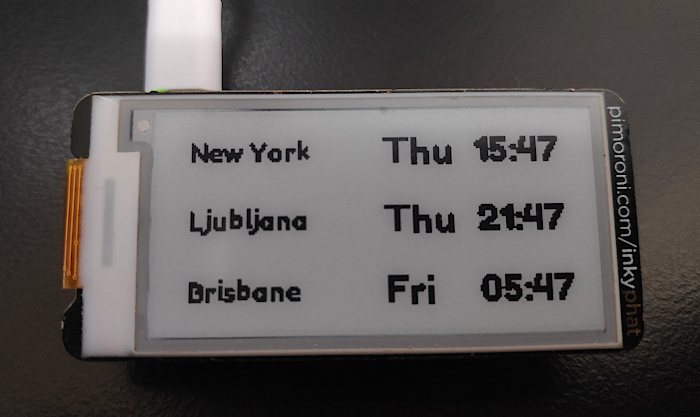Simple world clock with eInk display and Raspberry Pi Zero
post, Jun 26, 2021, on Mitja Felicijan's blog
Our team is spread across the world, from the USA all the way to Australia, so
having some sort of world clock makes sense.
Currently, I am using an extension for Gnome called Timezone
extension,
and it serves the purpose quite well.
But I also have a bunch of electronics that I bought through the time, and I am
not using any of them, and it's time to stop hording this stuff and use it in a
project.
A while ago I bought a small eInk display Inky
pHAT and I
have a bunch of Raspberry Pi's
Zero lying around that
I really need to use.
Since the Inky Inky
pHAT is
essentially a HAT, it can easily be added on top of the Raspberry Pi
Zero.
First, I installed the necessary software on Raspberry Pi with pip3 install inky.
And then I created a file clock.py in home directory /home/pi.
#!/usr/bin/env python
# -*- coding: utf-8 -*-
import sys
import os
from inky.auto import auto
from PIL import Image, ImageFont, ImageDraw
from font_fredoka_one import FredokaOne
clocks = [
'America/New_York',
'Europe/Ljubljana',
'Australia/Brisbane',
]
board = auto()
board.set_border(board.WHITE)
board.rotation = 90
img = Image.new('P', (board.WIDTH, board.HEIGHT))
draw = ImageDraw.Draw(img)
big_font = ImageFont.truetype(FredokaOne, 18)
small_font = ImageFont.truetype(FredokaOne, 13)
x = board.WIDTH / 3
y = board.HEIGHT / 3
idx = 1
for clock in clocks:
ctime = os.popen('TZ="{}" date +"%a,%H:%M"'.format(clock))
ctime = ctime.read().strip().split(',')
city = clock.split('/')[1].replace('_', ' ')
draw.text((15, (idx*y)-y+10), city, fill=board.BLACK, font=small_font)
draw.text((110, (idx*y)-y+7), str(ctime[0]), fill=board.BLACK, font=big_font)
draw.text((155, (idx*y)-y+7), str(ctime[1]), fill=board.BLACK, font=big_font)
idx += 1
board.set_image(img)
board.show()
And because eInk displays are rather slow to refresh and the clock requires
refreshing only once a minute, this can be done through cronjob.
Before we add this job to cron we need to make clock.py executable with chmod +x clock.py.
Then we add a cronjob with crontab -e.
* * * * * /home/pi/clock.py
So, we end up with a result like this.
You can download my STL file for the enclosure
here, but make sure that dimensions make
sense and also opening for USB port should be added or just use a drill and some
hot glue to make it stick in the enclosure.